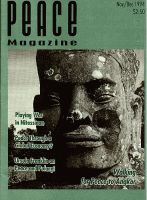
Peace Magazine Nov-Dec 1994, page 27. Some rights reserved.
Search for other articles by Alan H Weatherley here
Here's yet a second response to the debate about the biological basis for violence
Most people who work for peace have considered aggression of minor significance as a cause of war. The wars we had in mind were those fought by detached, icily efficient technicians who would have fired volleys of missiles without hating anyone or considering the moral implications of their actions. Peace-seekers, then, have paid scant attention to human aggressive impulses, but have concentrated instead on weaponry.
Yet, strangely few, if any, high tech wars have been fought of the kind we expected during the Cold War. The absence of such wars is, of course, a matter of profound relief.
What we do see today are many wars in previously peaceful societies, where savagery is done mostly with simple weapons-boots, clubs, and machetes. Great aggression is needed to kill thousands by such means in face-to-face blood baths. In this 1994 world of real wars, vicious aggression is alive and well.
Peter Nicholls suggests ("Affection/Aggression: Sides of the Same Coin," Peace Magazine Sept./Oct. 1994) that murder and war may be impossible to eliminate because of the deep propensity for deadly violence between humans.
Nicholls claims that our emotions are "ancient" in origin. "Aggression is involved in discriminating between self and other, family and stranger, mate, rival, or collaborator." Today, he rightly observes, we need to restrain our aggressive impulses-and to do so we need to "know what real violence is."
He seems to believe that aggression necessarily leads to damaging violence. I disagree. In fact, most ethologists, anthropologists, and psychologists do not believe that deadly violence is the norm in either animals or humans. Instead, aggression in vertebrates functions in securing mates, and in establishing and protecting territory for breeding, feeding, and guarding of young. Only rarely-and then dysfunctionally-does aggression lead to fights that injure or kill. Much aggression is ritualistic and does little damage to the contestants. It may help perpetuate populations by preventing overcrowding, while ensuring that those excluded will still be able to search, uninjured, for space elsewhere or rejoin the original population if conditions improve. Most biologists can understand such a view of aggression on normal evolutionary grounds, including much of the aggression found in culturally evolved, lawful human societies.
However, we still must account for the appalling violence in some societies and many current wars.
Let me list a few things that may be intensifying violence in our world.
In summary, I differ from Nicholls, who seems to consider high levels of human violence as normal, even in modern democratic societies. Instead, I see violence as dysfunctional in biological terms. Violent aggression occurs in vertebrate societies-including human societies-where there is anxiety, fear of attack by predators, severe overcrowding, or shortage of vital resources. Such aggression is abnormal and dysfunctional.
Societies marked by excessive violence are probably threatened societies. Nicholls may be right in believing that, because the U.S. was "created in violence," violence there has become nearly permanent, but I believe the U.S. is a disturbed society that sees itself as threatened. If the causes of social anxiety were reduced, its violence would also decline.
By its very title, Science for Peace ought to be studying the violence that endangers social justice and peace. Nicholls has done Science for Peace a service by posing the problem of human behavior as one of our concerns.
Alan Weatherley is a retired zoology professor, University of Toronto.

Peace Magazine Nov-Dec 1994, page 27. Some rights reserved.
Search for other articles by Alan H Weatherley here